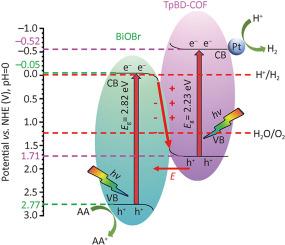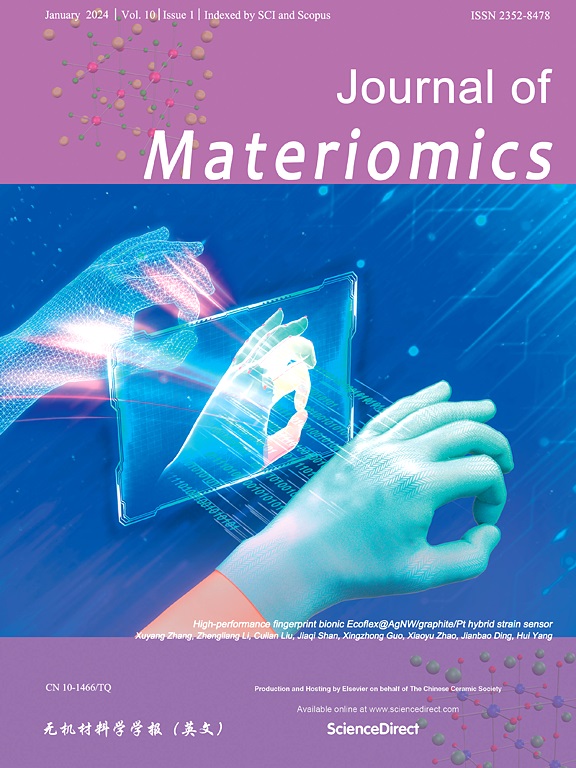通过相变策略设计 BiOBr/TpBD-COF S 型异质界面,促进光催化制氢
IF 9.6
1区 材料科学
Q1 CHEMISTRY, PHYSICAL
引用次数: 0
摘要
构建异质结是促进空间光诱导电荷载流子分离,从而加速光催化反应的有效方法。然而,作为影响电荷载流子扩散过程的关键因素,界面性质的调控仍然是一个重大挑战。在这项工作中,通过一种新颖的相变策略,成功地构建了 BiOBr/TpBD-COF 异质结。具体来说,首先合成了包晶Cs3Bi2Br9,然后在制备TpBD-COF的过程中将其原位转化为BiOBr,从而获得了具有良好界面的BiOBr/TpBD-COF异质结。根据原位 X 射线光电子能谱(XPS)表征和电子顺磁共振(EPR)分析,在内部电场的驱动下,光生电子以微弱的还原力从 BiOBr 向 TpBD-COF 转移,符合 S 型电荷转移模式。因此,具有强氧化还原能力的光生电子和空穴分别位于 TpBD-COF 和 BiOBr 表面,为水分离反应提供了强大的驱动力。优化后的 10%BiOBr/TpBD-COF 与 TpBD-COF 相比(5.18 mmol⋅g-1⋅h-1),光催化氢进化率显著提高(16.17 mmol⋅g-1⋅h-1)。这项研究将为开发基于 COF 的高效 S 型异质结光催化剂提供一些新的启发。本文章由计算机程序翻译,如有差异,请以英文原文为准。

Engineering BiOBr/TpBD-COF S-scheme heterointerface via phase transformation strategy for boosted photocatalytic hydrogen generation
The construction of heterojunction is an effective way to promote the photoinduced charge carrier separation in spatial, thus accelerating the photocatalytic reaction. However, the regulation of interface properties, as a crucial factor in affecting the charge carrier diffusion process, still remains a significant challenge. In this work, BiOBr/TpBD-COF heterojunction was successfully constructed via a novel phase transformation strategy. Specifically, perovskite Cs3Bi2Br9 was first synthesized and then in-situ transformed into BiOBr during the preparation of TpBD-COF procedure, thus obtaining BiOBr/TpBD-COF heterojunction with favorable interface. According to the in-situ X-ray photoelectron spectroscopy (XPS) characterization and electron paramagnetic resonance (EPR) analysis, the photogenerated electrons with weak reduction power transfer from BiOBr to TpBD-COF driven by the internal electric field under irradiation, conforming to S-scheme charge transfer mode. As a result, the photogenerated electrons and holes with strong redox abilities are spatially located on TpBD-COF and BiOBr surface, respectively, endowing the strong driving force toward the water splitting reaction. The optimized 10%BiOBr/TpBD-COF displayed remarkably enhanced photocatalytic hydrogen evolution rate (16.17 mmol⋅g−1⋅h−1) in comparison with TpBD-COF (5.18 mmol⋅g−1⋅h−1). This study will provide some novel inspirations for developing efficient COF-based S-scheme heterojunction photocatalysts.
求助全文
通过发布文献求助,成功后即可免费获取论文全文。
去求助
来源期刊

Journal of Materiomics
Materials Science-Metals and Alloys
CiteScore
14.30
自引率
6.40%
发文量
331
审稿时长
37 days
期刊介绍:
The Journal of Materiomics is a peer-reviewed open-access journal that aims to serve as a forum for the continuous dissemination of research within the field of materials science. It particularly emphasizes systematic studies on the relationships between composition, processing, structure, property, and performance of advanced materials. The journal is supported by the Chinese Ceramic Society and is indexed in SCIE and Scopus. It is commonly referred to as J Materiomics.
 求助内容:
求助内容: 应助结果提醒方式:
应助结果提醒方式:


